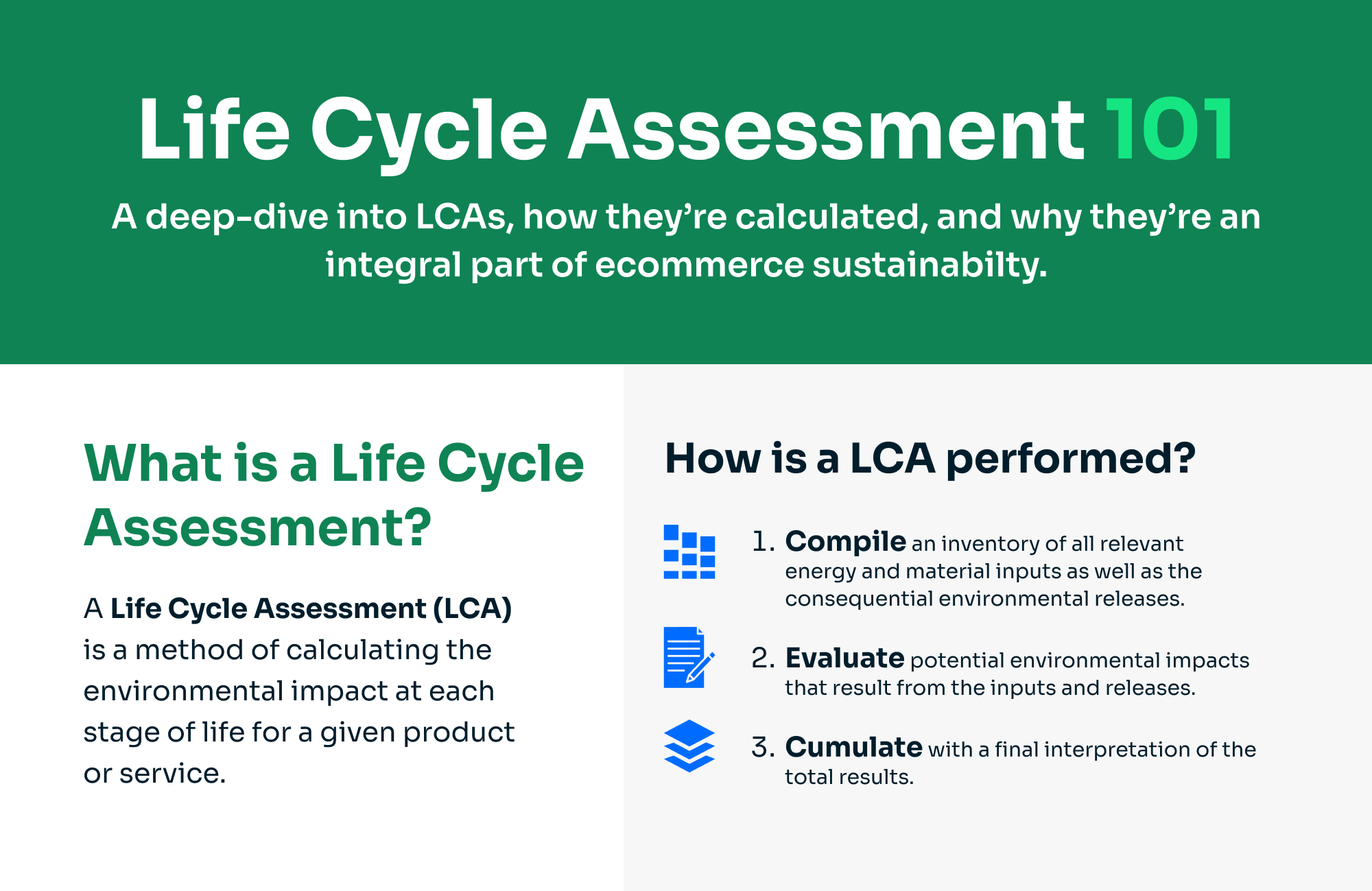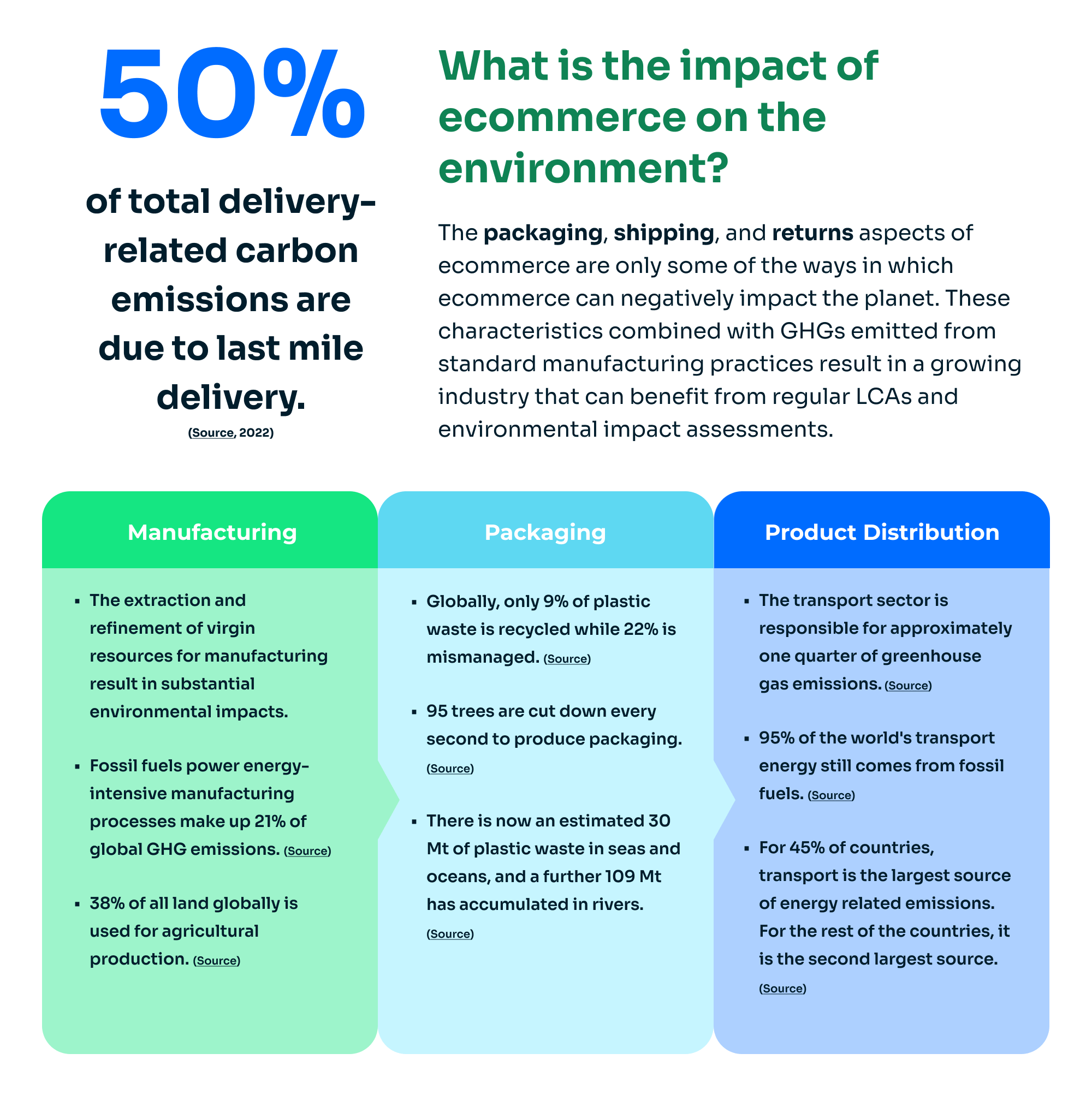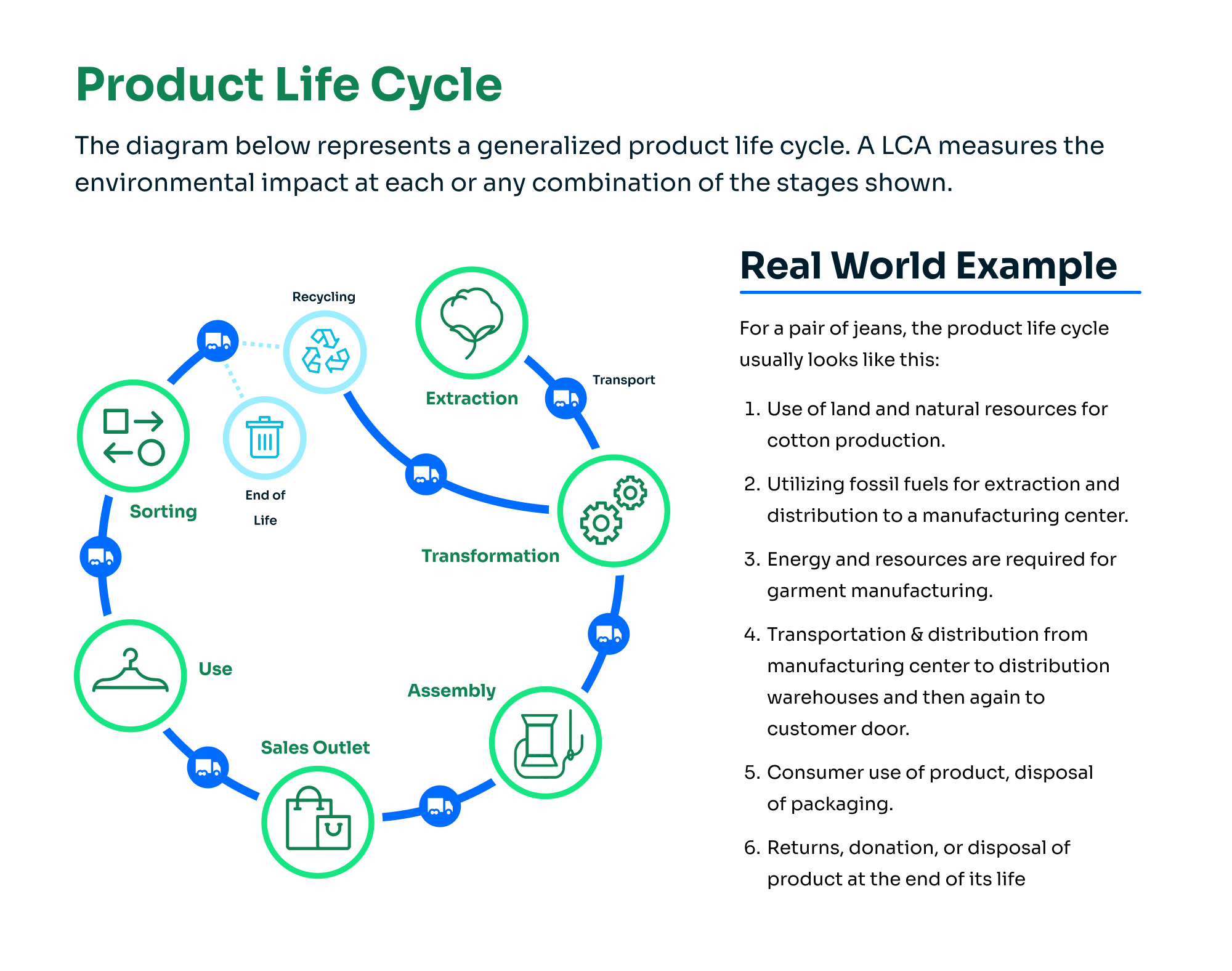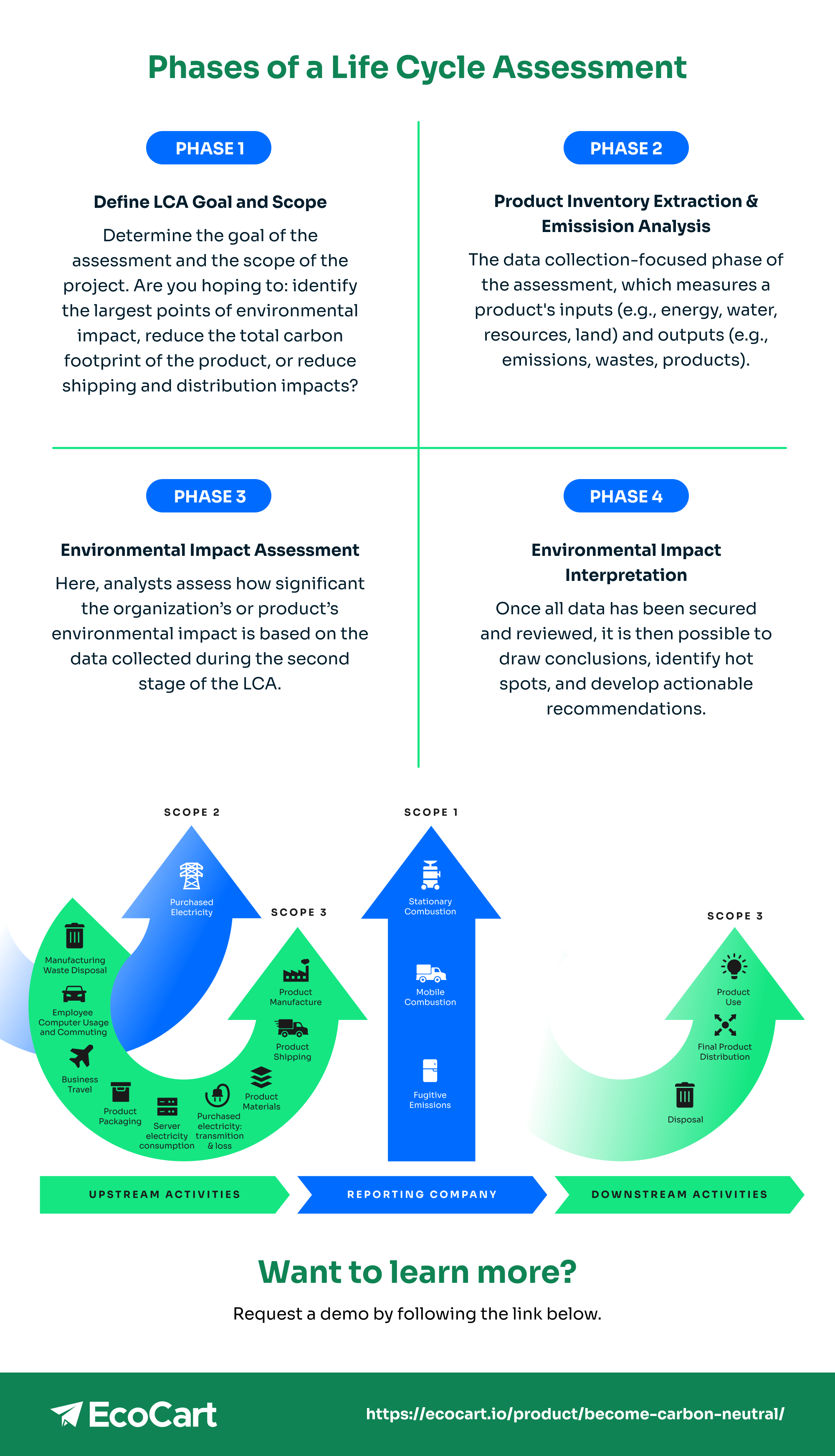These days it’s nearly impossible to go online without coming across ads for “sustainable” products for sale. Many companies use terms like “sustainable”, “green”, or “environmentally conscious” to describe their products—but how many of them truly know the environmental impacts of what they’re selling?
You may have heard environmental advocates or political decision-makers ask questions such as “what is the social carbon cost” of a product, action, or policy? This refers to estimating the degree to which a product or decision may positively benefit society while considering the amount of carbon that may be emitted and the effect this may have on climate change.
This is where life cycle assessments (LCAs) come into play. They are a way of calculating the total amount of carbon emitted throughout the lifespan of a product or service. Conducting an LCA plays an increasingly important role as the world of ecommerce takes steps to become more sustainable.
So, what is a life cycle assessment?

What is a Life Cycle Analysis?
LCA (life cycle assessment) is defined as the “systematic analysis of the potential environmental impacts of products or services during their entire life cycle”. LCAs are an incredible sustainability tool as they can precisely analyze environmental impacts such as energy consumption, greenhouse gas emissions, water usage, and waste generation. LCAs can also provide a fuller and more in-depth understanding of the carbon footprint at each stage of a product or service’s life.
An LCA will carefully measure every aspect involved in the creation, use, and disposal (also known as the life cycle) of a product, by looking into items such as: what materials were used in manufacturing the product, what method of transportation was used to deliver the final product or the amount of energy required during the use stage of the product.
The product’s stages of life include:
- Raw materials used
- Manufacturing
- Shipping
- The use of the product
- The product’s disposal or ‘end of life’
All of this data is collected in order to establish a comprehensive assessment of the total impact the product may have on the environment.
How do you perform a life cycle assessment?
An LCA is performed by looking at the environmental impact of a product or service at each stage of life. This is done by:
- Compiling an inventory of all relevant energy and material inputs and the consequential environmental releases
- Evaluating potential environmental impacts that result from the inputs and releases
- Cumulate with a final interpretation of the total results
What are the Benefits of Doing an LCA?
Anyone and everyone can benefit from a life cycle assessment. From the business or service provider selling the product down to the end user, it all trickles down to a greener economy.
Who Needs an LCA?
Anyone and everyone can benefit from a life cycle assessment. Since LCA’s are a method of assessing the environmental impacts of a product or service at each stage of its life, this information is beneficial for businesses looking to reduce their overall environmental impact, customers hoping to make more environmentally conscious purchases, and good for the planet in general.
The more aware all of us are about some of the negative impacts our daily decisions can have on the environment, the more opportunities we will find to help mitigate these impacts.
Download our FREE ebook:

Why LCAs are Important to Ecommerce
At EcoCart, we work with various brands with ecommerce platforms to calculate life cycle assessments in order to accurately assess the total carbon dioxide that is emitted from a product throughout its life.
The end goal? To calculate the carbon emitted from business operations in order to offset these emissions by partnering with various certified carbon offsetting projects. While there are many reasons why LCAs are important for ecommerce… we’ll start with three! By conducting a thorough life cycle assessment for each product we are able to
- Identify high-emitting transportation methods and encourage brands to find alternatives.
- Directly compare different product materials to see which are more sustainable than others.
- Provide companies with credible data to justify sustainable claims.
For example…
In 2021 an apparel company wished to offset the carbon emissions for various products offered on their website. We calculated the carbon emitted for different jackets, knitwear, dress shirts, and scarves. Three dress shirts that to the average consumer’s eye look nearly identical were analyzed. Here are some examples of how we used the data from an LCA to analyze a product:
- We observed that one of the shirts emitted a notably lower amount of CO2 when compared to two other shirts of similar size and style.
- We discovered that the weight of the low-emitting dress shirt was only 0.2 lbs lighter than the other two dress shirts.
By isolating weight difference as the only variable amongst the three shirts, we concluded that even the smallest adjustment in clothing weight could significantly reduce total carbon emitted.
Want to know where your business stands? Get your sustainability scorecard with our quiz:
What is the Environmental Impact of Ecommerce?
Ecommerce (electric commerce) refers to buying and selling products online. Since the beginning of COVID-19, global ecommerce use and reliance have drastically increased.
As our planet increasingly faces the negative effects of climate change, industries have begun reflecting on ways to become more sustainable. Online promoted events such as Big Billion Day or Cyber Monday have increased rates of unplanned or unnecessary purchases, which in turn increases the rates of product manufacturing and distribution.
The packaging, shipping, and returns aspects of ecommerce are only some of the ways in which e-commerce, specifically, can negatively impact the planet. These characteristics combined with CO2 emitted from standard manufacturing practices result in a growing industry that can benefit from regular LCAs and environmental impact assessments.
For example, a study conducted by an advocacy organization determined that Amazon alone generated 600 million pounds of plastic packaging waste in 2021. The carbon footprint of creating so much plastic can take a massive toll on the environment. Below we will detail the impact product manufacturing and distribution can have on the environment.

Manufacturing’s Impact on the Environment
To put it into perspective – the pair of jeans you threw on before running out the door. What did it take to create them? Every thread, button, and the zipper had to be produced and sourced from somewhere.
The raw materials required for a pair of jeans include natural fibers, synthetic materials, regenerated fibers, metals, as well as fossil and renewable fuels. All of these resources need to be sourced and extracted, and these processes will impact the environment in some way or another.
Let’s talk about water intake (freshwater taken from the environment) and land occupation (total land occupied to support the product system assessed). Both are required to plant and harvest the cotton necessary to create denim. However, it is important to then assess the impacts of denim water consumption (net freshwater taken from the environment minus water returned to the same watershed at the same quality or better) and whether the harvesting is depleting or taking away from nearby aquatic ecosystems or the local water cycle.
It’s a lot to factor in. And… there’s more…
Metals and minerals and energy.
Metals need to be sourced and energy is used by the machinery required to manufacture the product, you must also account for any abiotic depletion (a measure of the depletion of non-renewable resources that include fossil energy, metal, and minerals) and the carbon emissions that may result.
You see, there are countless ways the manufacturing process of one given product can impact the environment, but here is a brief overview:
- Sourcing natural resources, like water, and raw materials such as minerals and metals
- Fossil fuels are used in powering the manufacturing process as well as machinery to derive natural resources
- Occupation of land required to plant or harvest resources needed for manufacturing
- Carbon is emitted into the atmosphere due to the energy required to run necessary machines and equipment.
How Packaging Impacts the Environment
We’ve touched on the impact a product can have on the environment, however, environmental impact can be assessed at every stage of a product’s life— including its packaging. Sometimes, as consumers in the excitement of receiving our purchase, we overlook the extremely disposable packaging that came with it.
While our interactions with packaging may only last a short period of time, its impact on the environment can last much longer. For example, single-use plastics present one of the bigger concerns for environmentalists because they can persist in the environment, sometimes for hundreds of years. Often, the recyclability of single-use plastics is oversold. Currently, less than 14 percent of the nearly 86 million tons of plastic packaging produced globally each year is recycled. The vast majority are sent to landfills, incinerated, or left to pollute waterways and poison wildlife. In addition to this Oceana estimated that 22.44 million pounds of Amazon’s plastic packaging ended up in the world’s freshwater and marine ecosystems in 2019 alone.
In addition to single-use plastics, it’s important that we work towards less packaging altogether. Even our most sustainable cardboard packaging and mailers have an impact. In fact, 3 billion trees are pulped every year to produce 241 million tons of shipping cartons, cardboard mailers, void-fill wrappers, and other paper-based packaging, according to the forest conservation group Canopy.
How Shipping Impacts the Environment
Once a product has been created it finds its way to a distribution center, then either a shopping center or your front doorstep. This is what we refer to as the distribution and transportation stage of life for a product.
There are many methods of transportation your product might take. As you can imagine, there is an environmental cost associated with each stage of transportation. The most common methods of transportation are:
- Air (plane)
- Sea (freight shipping)
- Ground transportation (cars and trucks)
In 2018 the Environmental Protection Agency stated that the transportation sector alone accounted for approximately 28% of all US greenhouse gas emissions—the largest proportion of overall emissions. While passenger transport is a huge factor in these calculations, the transportation of goods still plays a large role.
When you account for the distribution and transportation stage of a product’s lifecycle, you are able to assess the proportion of environmental impact that stage has relative to the entire life of the product. Companies looking to reduce their total environmental impact are able to compare various shipping and transportation methods that are cost-effective and less harmful.
One way companies can reduce their environmental cost of shipping and distribution is by identifying alternatives to fossil fuel-dependent vehicles or analyzing their overall supply chain to find ways to streamline and reduce long-distance shipping.
To sum it up:
- Transportation accounts for 28% of all GHG emissions
- Fossil fuels are generally used to create the energy used to power distribution centers and the transportation to get products from manufacturing and packaging centers to distribution warehouses
- A large amount of landfill waste is created from product returns, which use fossil fuels to transport products
- Emissions from returns transportation account for 27 million tons of carbon emissions annually.
Are online purchases or traditional retailers greener when it comes to distribution?
LCA’s have been conducted comparing the differences in environmental impacts between traditional retail purchases and online purchases. These studies have demonstrated that “e-commerce delivery uses less primary energy and produces fewer CO2 emissions than traditional retailing”.
In the traditional retail experience, customer transport accounts for around 65% of total energy expenditures and CO2 equivalent emissions on average. When you make a purchase online, the package is streamlined to arrive at your door—transporting to a retail location and having to transport yourself to the retail location and back is skipped in ecommerce. This information is incredibly useful for consumers hoping to reduce their overall carbon footprint and environmental impact.

Life Cycle Assessment of Products Explained
As you know, an LCA is a process of measuring the environmental impact of a product at each stage of its ‘life’. As you can imagine, this requires a variety of steps to get to the final impact. Below is a breakdown of the prominent phases of an LCA and some of the challenges or limitations associated with each.
Who Performs an LCA?
Environmental consultants, sustainability analysts, and companies such as EcoCart can conduct an LCA. International protocols such as ISO 14040 and 14044, and the Greenhouse Gas Protocol provide guidelines detailing what considerations must be made when making life cycle calculations such as what emission factors should be used, what utility bills will need to be requested, and how to ensure double-counting does not occur.
These protocols help to standardize a relatively new process in the sustainability field and break down LCAs into four distinct phases.
What are the four phases of a life cycle assessment you ask? ISO 14040 and 14044 break down an LCA into four distinct phases:
(1) Goal and scope
(2) Life cycle inventory
(3) Life cycle impact assessment
4) Interpretation of the results
Some analysts can choose to break these stages down even further, however, the standard four mentioned above are the starting point for any given LCA.

Phase 1: Determine LCA Goal & Scope
There are many reasons why a life cycle assessment might be performed, that’s why the first phase of a life cycle assessment is to determine the goal of the assessment and the scope of the project. Are they hoping to: identify the largest points of environmental impact, reduce the total carbon footprint of the product, or reduce shipping and distribution impacts?
Identifying the LCA goal is critical when setting the scope of the overall project as one’s scope sets the boundaries of the assessment. Your goal can influence your scope by determining whether you are conducting a cradle-to-grave LCA, a cradle-to-gate LCA, or even just calculating emissions for the transportation and distribution stage. Your LCA scope and goal will also impact what Impact Categories will be assessed in the Environmental Impact Assessment portion of an LCA.
And what do cradle to grave and cradle to gate mean?
They are two common types of life cycle analysis.
- Cradle-to-grave LCAs measure the impact of a product’s raw material extraction (cradle) all the way to its disposal (grave).
- Cradle-to-gate LCA assesses a product from raw material extraction until it reaches its final form and is ready to be shipped to customers.
While these two terms may be frequently used, there are other LCA variants, such as cradle-to-cradle (for products that can be fully recycled) or well-to-wheel (LCAs that focus on transport fuels and vehicles) amongst many others.
Phase 2: Product Inventory Extraction & Emission Assessment
This is the data collection-focused phase of the assessment, which reviews the raw materials and resources required for the product, the different types of energy recorded in the manufacturing stage, overall water use, as well as all air, land, or water emissions. A lot of this data can be readily found in electricity or water bills for manufacturing and production buildings or in shipping records, however sometimes industry averages approved by various organizations must be used.
Data is then used to quantify the environmental impact at the various stages of a product’s life.
Some refer to this as the Life Cycle Inventory phase of an LCA. It usually requires the largest amount of time and is often the most work. This is due to the fact that this stage requires analysts to quantify all environmental inputs and outputs relevant to the product or service being analyzed.
Emissions categories
The GHG Protocol, a comprehensive global standardized framework that measures and manages greenhouse gas (GHG) emissions, classifies emissions into Scopes 1,2, and 3. Scope 3 covers emissions that the company is indirectly responsible for up and down its value chain which is then further broken down into 15 categories. Below is a brief overview of the categories most frequently used in an LCA analysis.
- Category 1: Purchased Goods & Services: This category refers to the extraction, production, and transportation of any goods and services purchased by the company involved in the development of the product being analyzed.
- Category 4: Upstream Transportation & Distribution: This section specifically deals with data focused on the transportation and distribution of products and services purchased (e.g. vehicles and facilities not owned by the reporting company).
- Category 11: Use of Sold Products: The end use of goods and services sold by the reporting company. This category calculates the use phase of emissions for the expected lifetime of the product being sold.
- Category 12: End-of-Life Treatment of Sold Products: This category calculates the emissions involved in the waste disposal and treatment of the product sold by the reporting company.
By conducting LCAs that include each of the above categories from the GHG Protocol, analysts can ensure that an all-encompassing approach is taken when calculating the total emissions for a product.
Phase 3: Environmental Impact Assessment
In the environmental impact phase of the overall life cycle assessment, analysts assess how significant the organization’s or product’s environmental impact is based on the data collected during the second stage of the LCA.
There are 15 impact categories analysts can use in their LCA assessments including but not limited to: climate change, ozone depletion, acidification, or human toxicity.
During the final steps, the equivalents for each of the environmental impact categories are calculated and summed to represent overall impact category totals.
Phase 4: Environmental Impact Interpretation
Once all the data has been secured and reviewed, it is then possible to draw conclusions and recommendations.
A typical LCA interpretation will identify significant issues raised in the emission assessment or then environmental impact assessment such as extremely large points of emission or overwhelming calculations of human toxicity.
The interpretation will also provide an overview of the LCA itself and discuss items such as whether additional data could be reviewed or whether the data appears consistent with previously conducted LCAs. Each interpretation is concluded with an overall assessment of the LCA that summarizes any limitations identified and any recommendations that may result from the investigation.
LCAs Identify Opportunities for a Greener Economy
In conclusion, LCAs are an incredible tool that businesses can use to identify opportunities for improvement in the products they sell at every stage of that product’s life. LCAs can provide valuable insight to companies that strive to keep up with the green transition that is taking place across industries globally. Reach out to learn how EcoCart can help you with your life cycle assessment.



